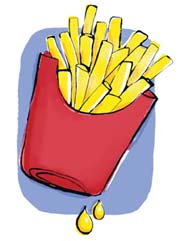 |
 |
| current issue |  |
past issues |  |
send a letter/news |  |
address update |  |
advertise |  |
about us |  |
alumni home |
by Amos Esty
Illustrations by Marian Richardson
In this issue:
Risk AnalysisMuddy Waters
Soap-free Biodiesel
Risk Analysis
Fire-retardant chemicals, present in breast milk, may be linked to obesity

|
In the 1970s, manufacturers began adding flame-retardant chemicals called polybrominated diphenyl ethers (PBDEs) to mattresses and carpeting. The goal was to save lives by preventing the spread of fires. But Gale Carey, a UNH professor of nutritional sciences, says that the benefits of PBDEs need to be weighed against their risks. The chemicals are now used in a long list of common items, including TVs, computers and household appliances.
PBDEs are present in the environment and our bodies, but it's not clear how they get there. One possibility is aging and wear of consumer products; another is direct exposure during use. In any case, PBDEs settle in dust and make their way into water, fish, soil, animals and foodstuffs. The chemicals also dissolve in fat, so foods that are high in fat, like meat, fish and dairy products, contain measurable levels of them.
To find out how much is present in people's bodies, graduate student Rebecca Dunn devised a study that measured PBDE levels in breast milk from a group of 40 local women. She found approximately 30 nanograms of PBDEs per gram of fat in the breast milk, on average. That's much higher than the levels in breast milk in other parts of the world, but it remains unclear how high levels have to be before there's cause for concern. "We don't know when to start worrying," says Carey. "And so that's a worry."
Carey is studying the effect of PBDE exposure in animals, and she's particularly interested in a possible link to obesity. She started researching the subject after coming across studies showing that PBDEs can disrupt the endocrine system, which includes the thyroid gland. "That caught our eye because thyroid hormone is so intimately involved in metabolism, which is tied into body weight," she says. Carey and other researchers began to wonder whether environmental chemicals could be involved in the obesity epidemic.
In one study, Carey gave a group of rats a dose of PBDEs every day; another group was unexposed. After two weeks, and again after four weeks, she removed fat tissue and exposed it to different hormones. She found that PBDE exposure made the rats' fat cells less sensitive to insulin and more sensitive to epinephrine (adrenaline), conditions also found in people who are on the cusp of excessive weight gain and even Type 2 diabetes. Carey says it's "almost like a pre-obese state."
In this short study, the rats gained the same amount of weight regardless of PBDE exposure, but metabolically, their cells behaved differently. Carey led a small, longer-term study in which rats were exposed to PBDEs both before birth (through their mothers) and for their first five months. As Carey suspected, PBDE exposure was associated with higher body weight, although she cautions that the results are preliminary.
Given that many people have now been exposed to these chemicals for their entire lives, Carey think it's essential to figure out the public-health implications. Using the chemicals without knowing more about them is like conducting a large-scale experiment where, she notes, "we're all part of the experiment."
Muddy Waters
Pollution in rivers can have a ripple effect downstream
Some of the benefits provided by the Lamprey River to southeastern New Hampshire, such as drinking water and recreation opportunities, are obvious. But one of the river's most important functions goes almost unnoticed—filtering waste and preventing it from reaching fragile coastal ecosystems downstream.
William McDowell, a professor of natural resources and water resources management, has been studying the role of the Lamprey in the local ecosystem since 1999, and what he has found causes him some concern. He explains that thanks to the Lamprey River and its riparian zone (the interface between the land and the river), only a small fraction of the nitrogen created by agricultural runoff, waste disposal and sewage ever makes its way to the Great Bay Estuary. But, he says, as the amount of nitrogen in a river increases, the ability of the river to filter it out decreases. And at some point, it's possible to overload the filtering ability of the river altogether.

|
With the help of graduate students and other researchers, McDowell has taken weekly samples of water and soil from the Lamprey River and its watershed for nine years. By analyzing the samples, he hopes "to understand the changes in water quality and what we call biogeochemical processes—all of the things that the microbes, plants and soils do."
One key finding so far is that there is a clear correlation between human population and rising levels of nitrate. McDowell explains that high nitrate levels don't do much damage in the river itself—it's downstream where the river empties into the Great Bay Estuary that it can cause significant degradation. An increase in nitrate can cause the growth of algae, for example, which then crowds out eelgrass, affecting fish and other organisms that rely on eelgrass for food. If the algal bloom gets massive enough, it can crowd out marine life.
Every year, these "dead zones" occur in U.S. coastal areas. The largest of these is located in the Gulf of Mexico at the mouth of the Mississippi River, where it annually grows to about 7,000 square miles at its peak in mid-summer.
McDowell is certain that humans are responsible for escalating nitrate levels in the more populated areas of the Lamprey River watershed. "The nitrate is higher than you could ever get by a natural process," he says. One piece of evidence from his long-term study is that nitrate concentration varies widely depending on the area of the watershed the samples are taken from. More developed areas tend to have higher nitrate levels: "The more people, the more nitrate."
Increased awareness of the effects of nitrate pollution, McDowell hopes, may lead to the use of advanced septic systems and pervious pavement, which absorbs and filters water. Other basic steps to reduce individual contributions to the problem include driving less and reducing the use of lawn fertilizer.
What's really needed, he says, is more appreciation for the Lamprey's essential, but invisible, services.
Soap-free Biodiesel
There may be a better way to make biodiesel from oil
When diesel engines were first designed in the late 19th century, they were intended to run on plant oils. But with the rise of the petroleum industry, petrodiesel—a byproduct of gasoline production—changed those plans. Today, about 40 billion gallons of diesel fuel are burned each year to run diesel-powered trucks and cars in the United States, and almost all of it still comes from petroleum.
If it's up to P.T. Vasudevan, a professor of chemical engineering, more of that fuel will once again come from the plant-based diesel called biodiesel. "To the extent possible that we can decrease our dependence on fossil fuels, especially petroleum, we should," he says. In addition to the well-known pollution problems caused by fossil fuels, there's the matter of supply. Demand for petroleum is already at about 85 million barrels per day, and that figure is expected to rise even as supplies dwindle.

|
Most of the biodiesel produced in the United States today comes from soybeans. But Vasudevan points out that it takes energy—petroleum-based fertilizer, tractors, trucks—to grow and transport the crops. Using soybeans also reduces the country's food supply, driving up prices. He hopes to put another resource to use: the cooking oil used in restaurants. This explains why he has a jar of used cooking oil sitting in his laboratory. He can take that oil, filter out the remnants of food collecting at the bottom of the jar (French fries, perhaps?) and combine it with methanol, which is made from natural gas or coal gas, to produce biodiesel.
The other part of the process is the addition of a catalyst to trigger the reaction of the oil in methanol. Usually, the catalyst is sodium hydroxide. But sodium hyroxide can be unsafe to use—"it's quite a nasty chemical," says Vasudevan. And combined with waste oil, sodium hydroxide produces soap as a byproduct. "In pure cooking oil, you have triglycerides," Vasudevan explains. "In waste oil, a lot of the triglycerides are broken into fatty acids. And when you have a fatty acid containing water reacting with an alcohol, that's one way of producing soap." It's hard to separate the soap from the biodiesel, which adds time and expense to the production process.
So Vasudevan is experimenting with the use of enzymes in place of sodium hydroxide. He and his graduate students are experimenting with the enzyme lipase, which is just as effective as sodium hydroxide, without producing any soap. Another benefit of lipase is that it can be used in solid form, meaning that it can be easily extracted and reused. Sodium hydroxide mixes with the reactants, and must be used in the correct proportions to make biodiesel. There is a catch. "It's not economical at all, right now," Vasudevan admits. The problem is that lipase is expensive. But he adds that there are a number of ways to reduce the cost. One current focus of his work is to increase the number of times the enzyme can be reused. Right now, it can be used up to eight times. If he could increase that to about 100 times, the use of lipase would be competitive with sodium hydroxide—without all the drawbacks.
blog comments powered by Disqus
